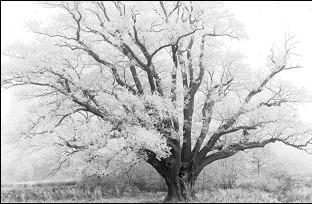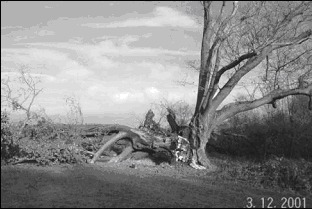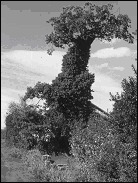
The Mawley oak photographed 27th November 1991 showing the tree before its collapse (photo B M Stephens)
This article was developed from Wyre Forest Study Group Report 2001
By B M Stephens
The mighty Mawley Oak collapsed at about 9.00am, Monday, 29th October, 2001, after a long period of increasing weakness. There had been some strong SW winds for several days preceding but, on this morning, not exceptional, W to NW, about force 5 perhaps gusting 6. Possibly the change of wind direction was significant and the extra strain more than the tortured trunk could stand. Witnesses, at the garage opposite, heard a loud crack and down it came, "Just like that!" narrowly missing the main road.
This is not an obituary. Demise is a more suitable term than death. The tree is far from dead, although, for the time being, a shattered fragment of its former self. The SE portion survives intact with a tall upright branch and several long branches spreading at various angles, from the original crown. The short main trunk has split through its diameter on a SW-NE axis down to ground level. The half nearest the road is again split down its radius, leaving the tree in three huge sections, with the fallen boughs spread over a wide area on the ground.
So, the roots are intact, the branches remain attached even if some are split, the original height remains (almost, but looking vulnerable), and there would seem no reason why the tree can not continue to grow. One would expect new shoots to arise next spring from dormant buds and the fractured edges. Like a coppiced stool, there will be many young shoots but, left alone, or even selected, we could hope that strong new branches will grow upwards eventually developing an even greater tree. It would be a most regrettable loss should the fallen branches be removed.
Demise, from the Old French demise, to lay down, refers to the transfer of a sovereign's crown to a successor. Young trees from acorns of the Mawley Oak are already established, and new growth will flourish from the extant tree. The habit of the tree suggests that it was pollarded years ago and now we can see the effect. Dead leaves collected in the crown of branches, rain drained down and from this mass of accumulated humus, rot spread into the heart.
Dr. Norman Hickin describes the Mawley Oak in his book The Natural History of an English Forest (Hutchinson 1971 page 6). He recorded, to within ten days of the collapse, exactly, thirty-three years ago.
"This tree is situated near the junction of the B4202 road from Clows Top and the A4117 road from Far Forest to Cleobury Mortimer...... measuring the tree on 19th October,1968 ..... The girth at head height, over a very rough trunk, was 23 foot 6 inches,giving a diameter of practically 7 foot 6 inches. The area on the ground covered by foliage was 1,417 square yards, well over a quarter of an acre ...... Perhaps the most outstanding point about this tree is the very.large number of main branches, although difficult to count these were made out as thirty and all arose from between 12 and 15 feet from the ground. So that the Mawley Oak has a broad but very short trunk, but with a magnificent head. The height was reckoned at 86 feet. The bark was extremely crevassed to the extent that it held the nest of a wren and one small branch was rotten and a colony of honey bees were flying in and out of a hole in it."
Although more accessible, the branches are still confusing to count. Since 1968 some have been lopped and others fell in 1974. Of Dr.Hicken's thirty, twenty four can be identified, (including cut stumps). The standing section has eight, the fallen NE part seven and the fallen NW part nine, suggesting that six fell in 1974. The main trunk is just twelve feet to the base of the branching. The girth of several fallen branches can be measured at their base. On the NE section the girth of three branches can be measured as 7 ft 6 in, 7ft and 6 ft 6in. To the NW the most distinct branch is 8 ft 6 in girth. At the equivalent of 32 feet above ground, three other branches measured 5ft 2in, 4ft 8in, 4ft 9in. giving some idea of the massive scale of this tree.
Estimates of age from girth measurements can only be approximate. Some comparisons are possible with other oak trees in the forest, but growth rates will be variable, affected as they will be by ground water supply, shading and soil in particular. Two specimens as standards grown from old stools in Lord's Yard coppice felled in the winter of 1990-1991 gave ring counts of 100 years and girths of 4ft 9in and 4ft 10in. Thus having grown since 1890, arithmetic suggests growth rates of 0.73 inch and 0.87 inch, respectively, per ten years. Of course one needs a larger sample to determine a better estimate.
Bordering the road (B4194) at Clogs Bank, to the SW, there is a stand of oak of varying sizes shown on the Stock Map as of 1890, while across the road to the NE is a similar stand of 1905 oaks. The girth, at chest height, of eighteen of the largest specimens with straight clear trunks, was measured from each stand.
| Compartment | ||||||
| 8059c | 6'2" | 5'3.5" | 6'3" | 5'6.5" | 5'6.25" | 5'8.5" |
| 8058f | 5'11" | 4'7" | 5'6" | 6'1" | 6'5" | 6'2" |
| 8057b | 5'11.5" | 5'6" | 5'5" | 5'1" | 6'1" | 5'4" |
Average girth = 5.69ft = 5' 8.25". Standard error of sample mean = 0.110ft = 1.32"
| Compartment | ||||||
| 8049b | 6'4" | 6'2.5" | 5'1" | 6'6.5" | 5'8.5" | 5'11" |
| 8048b | 5'7" | 6'2.5" | 5'5" | 5'8" | 7'6.5" | 5'11" |
| 8045e | 6'3.5" | 7'5.25" | 8'0.5" | 5'7" | 6'2" | 6'8.5" |
Average girth = 6.24 ft = 6'3". Standard error of sample mean = 0.185ft = 1.54"
The average girth of the older trees was 5ft 8¼ in. (5.69 ft,), and that of the trees fifteen years younger was 6ft3in. (6.24 ft). These figures correspond to growth rates of 0.97" per ten years over 111 years, and 1.24" per ten years, over 96 years.
From this sample the younger trees have grown faster. However, if the larger tree from Lord's Yard was still growing at 0.87inch per ten years it would now have a girth of 5ft 0in., still smaller than the samples from Button Oak. Clearly, as can be seen, Wyre Forest oaks grow at different rates in different parts of the forest, but girth is not an accurate indicator of age.
The Mawley Oak in its open, well-watered position, could be assumed to have a good growth rate. The girth of branches, cited above, is similar to the finest specimens in the 1905 sample. It would seem fair to conclude that the pollarding occurred around 1900, or the latter part of the nineteenth century.
With higher and lower estimates of growth rate the figures can be applied to Dr. Hickin's measure of the trunk of the Mawley Oak in 1968. This gives a radius for the trunk of 42.25 inches. The lower estimate of 0.073 inch growth per year divided into 42.25 would give an age of 578 years, plus the 33 to the present equalling 611, suggesting that the tree may originate from 1390. Using the higher estimate of 0.124 inches per year, similar calculation gives an age of 373 years, and an origin about 1628. This latter might seem more plausible, but without any study of growth rings we can only make very rough estimates.
In 1974 the tree suffered some loss of branches from the NW side. A large section of wood from the tree was set up at the, then newly established, visitor centre at Callow Hill, and a plaque set on the fence to the west. The notice reads:
The Mawley Oak April 1975 Estimated age 240 years Height 90 feet Girth breast height 24 feet Max. spread of canopy 130 feet In August 1974 several large branches broke away from the main trunk, probably due to an earlier lightening strike coupled with the great weight of the lower limbs. Local residents and supporters of the Cleobury Mortimer Branch of the Shropshire Conservation Trust, raised a sum of £343 to carry out the necessary work for the preservation of this fine tree. Young oaks were also planted near it.
Work has been done on the tree from time to time and the last few years have shown some stag's heading.
In recent years other local great and significant trees have suffered. The Seckley Beech and Preacher's Tree have gone. The Royal Oak at Boscobel has suffered storm damage (its ancestor acquired fame just 350 years ago) and the Mitre Oak is but a remnant. The Goodmoor Oak thrives and the giant Sweet Chestnut at Kate's Hill continues to spread. In contrast, the once unique, Witty Pear has received enhanced prestige with many successful propagations and newly discovered specimens in other parts of the Country. The survival of these special trees emphasises the constant need for long term and sustained measures for conservation of all species.
(The Wyre Forest Study Group Review 2001 contains pictures of the Mawley Oak and the front cover is graced by a magnificent picture of the multi-stemmed Seckley Beech taken 1973 before that tree collapsed. The Ancient Tree Forum web site also contains (and hopefully still does) an account of the recent collapse of the Mawley Oak and a photo: www.woodland-trust.org.uk/ancient-tree-forum. The photo is reproduced here with Roy Finch's permission. Although the Mawley Oak is just across the border into Shropshire I feel sure any information about the Wyre Forest will be of interest to readers of Worcestershire Record, hence this article. Ed)

The Mawley oak photographed 27th November 1991 showing the
tree before its collapse (photo B M Stephens)

The Mawley Oak after its collapse 3rd December 2001 (photo Roy
Finch). This was shown on the Ancient Tree Forum website.


These two pictures are of the Mitre Oak, near Crossway Green.
The one on the left is from the Transactions of the
Worcestershire Naturalists' Club bound volume for 1897-1899. This
and other plates are credited to Edwin Lees and the drawing must
have been much earlier in the 1800's.
The photo on the right (taken by Harry Green) shows the ivy-clad remnant of the Mitre Oak in the summer of 2000.
| WBRC Home | Worcs Record Listing by Issue | Worcs Record Listing by Subject |